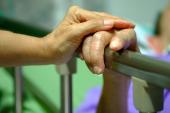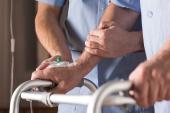Greater Frailty Means More Complications, Higher Mortality After PCI
Clinicians should assess frailty more formally before PCI, so the knowledge can help guide discussions with patients, say experts.

Frailty is common among older patients undergoing PCI in the United States, and the more severe it is, the greater the likelihood of complications and of dying in the hospital, data from the CathPCI registry shows.
Greater frailty was also tied to poorer PCI results irrespective of patients’ bedside mortality score, lead authors Benjamin Peterson, MD (St. Elizabeth Healthcare, Edgewood, KY), and Ajar Kochar, MD (Brigham and Women’s Hospital, Boston, MA), and colleagues report in a study published online ahead of the June 24, 2025, issue of the JACC.
Looking for frailty in a more routine way may help refine the shared decision-making process around PCI, they say.
Indeed, it’d be a good idea to incorporate some type of frailty assessment into risk scores, particularly when treating older patients, Deepak Bhatt, MD (Mount Sinai Fuster Heart Hospital, Icahn School of Medicine at Mount Sinai, New York, NY), senior author of the study, told TCTMD.
“It might help in some cases also to mitigate against age bias” and prevent clinicians from assuming what older patients might want in terms of their care, he added. “Assessing frailty puts some objectivity to it.”
‘Strikingly High’ Mortality in Some Scenarios
More than half of PCIs are performed in patients older than 65 years, a group that also accounts for a disproportionate share of PCI mortality (about 80%). There are, however, limited data on the prevalence of frailty in this population.
To explore this, the investigators examined data from the CathPCI registry, part of the American College of Cardiology’s National Cardiovascular Data Registry (NCDR). The analysis included more than 1.3 million patients 65 years or older (mean age 74.6 years; 34% women) who underwent PCI between October 2018 and December 2021.
Patients were divided into four groups according to their score on the Canadian Study of Health and Aging Clinical Frailty Scale (CFS), which assesses impairments in activities of daily living like bathing and dressing as well as instrumental activities of daily living like using a telephone, driving, and managing medications:
- Nonfrail (CFS 1-2): 6.0%
- Prefrail (CFS 3-4): 67.8%
- Frail (CFS 5-6): 21.6%
- Severely frail (CFS 7-9): 2.2%
Frail patients tended to be older, were more likely to be women, and were less likely to undergo elective procedures compared with others. The most common PCI indications were NSTEMI in frail patients (47.1%) and STEMI in severely frail patients (40.7%).
Overall, the rate of all-cause mortality in the hospital was 2.4%, ranging from 0.5% in nonfrail patients up to 20.3% in those with severe frailty; rates were 1.1% and 3.3% in the prefrail and frail, respectively.
The relationship between increasing frailty and higher mortality was evident across tertiles of the bedside mortality score and within various clinically relevant subgroups, including those with cardiac arrest, shock, chronic total occlusion (CTO), mechanical support, and severe calcification and those undergoing a left main coronary intervention.
Patients with severe frailty had “strikingly high” mortality rates across complex scenarios, according to the researchers, such as when they underwent PCI in the context of cardiac arrest (44.2%), cardiogenic shock (51.0%), mechanical circulatory support (46.1%), CTO (23.9%), left main occlusion (29.6%), and severe calcification (22.4%).
Rates of various complications, like bleeding, the need for transfusion or new dialysis, vascular problems, and stroke, also consistently went up with greater degrees of frailty.
“These data showing the association of frailty with mortality risk should not justify withholding PCI, especially in acute coronary syndromes,” the investigators stress. “However, frailty status, even prefrailty, strongly influences procedural risk and should inform shared decision-making. Older patients often prioritize independence and avoidance of complications affecting cognition. Increased bleeding risk among frail patients supports guideline recommendations favoring radial access in older adults.”
Eye-opening Results
David Fischman, MD (Jefferson Health, Philadelphia, PA), who was not involved in the study, said the findings are not surprising but could be “eye-opening for those who aren’t aware of this” and should get physicians thinking about how best to care for frailer patients. “Sometimes, we probably do things on frail patients that don’t need to be done, so I think it hopefully will create a conversation in terms of how we should approach these patients,” he said.
Before PCI, interventional cardiologists are likely assessing frailty using “an eyeball test” and not more formal tools, Fischman said, noting that in other scenarios in the cath lab—for structural heart interventions, for instance—it’s more formalized.
These new findings support standardizing the assessment of frailty for PCI as well. “We should be making sure we’re doing the right thing and not just doing it for the sake of doing it,” he said. “I think there should be some type of risk assessment. The problem is there are so many more PCIs and cardiac caths being done, and I’m not sure everybody will take the time to really do a true assessment as you do with the structural heart patient, which is a longer process.”
There’s also a need to perform more research into how accurate clinicians are in assessing frail patients and whether existing tools are the most appropriate for that task, said Fischman.
In an accompanying editorial, John Dodson, MD (New York University Grossman School of Medicine, New York, NY), and Ashok Krishnaswami, MD (Kaiser Permanente San Jose Medical Center, CA), say the routine assessment of frailty in cardiovascular care “is long overdue,” noting that these new findings are in line with prior studies.
“To truly transform care for older adults, we must incorporate frailty testing into routine clinical practice, embedding it as a standard part of every assessment, much like we do for vital signs,” they write.
The editorialists say individualized assessments, ideally involving a multidisciplinary team, are needed to guide clinical decision-making, with that process either bolstering the decision to perform a procedure or leading to a reconsideration. They also tout interventions to prevent or reverse frailty to improve health outcomes before and after PCI.
Finally, Dodson and Krishnaswami call for clinical trials to explore whether frailty can be modified and whether reducing it will influence outcomes in the future. If frailty isn’t modifiable, they say, “determining optimal ways of counseling patients and their caregivers on expected outcomes is of key importance.”
Bhatt, too, said a frailty assessment can help individualize the decision about whether to perform PCI and provide additional information beyond chronological age. “If somebody is 80 and frail, it might not be a wise thing to do an elective PCI on them for angina, whereas if somebody is 90 and not frail, a procedure when indicated, such as PCI in the right setting, could be quite reasonable.”
Todd Neale is the Associate News Editor for TCTMD and a Senior Medical Journalist. He got his start in journalism at …
Read Full BioSources
Peterson B, Kochar A, Young R, et al. Effect of frailty on in-hospital mortality and complications of PCI: an NCDR registry report. JACC. 2025;85:2416-2420.
Dodson JA, Krishnaswami A. Frailty and PCI outcomes: turning registry insights into health system action. JACC. 2025;85:2421-2423.
Disclosures
- The study was supported by the NCDR.
- Peterson reports having received unrelated grants from Edwards Lifesciences, Egnite, and Janssen and consulting fees from Amgen, Medtronic, and CRF.
- Kochar reports having received grants from the American Heart Association, Shockwave, and Rampart and consulting fees from Faraday Pharmaceuticals and Abiomed.
- The study was supported by the NCDR. Peterson reports having received unrelated grants from Edwards Lifesciences, Egnite, and Janssen and consulting fees from Amgen, Medtronic, and CRF. Kochar reports having received grants from the American Heart Association, Shockwave, and Rampart and consulting fees from Faraday Pharmaceuticals and Abiomed. Bhatt reports having been on advisory boards for Angiowave, Bayer, Boehringer Ingelheim, CellProthera, Cereno Scientific, E-Star Biotech, High Enroll, Janssen, Level Ex, McKinsey, Medscape Cardiology, Merck, NirvaMed, Novo Nordisk, Stasys, and Tourmaline Bio; having been on the board of directors of the American Heart Association New York City, Angiowave (stock options), Bristol Myers Squibb (stock), DRS.LINQ (stock options), and High Enroll (stock); having received consulting fees from Broadview Ventures, Corcept Therapeutics, GlaxoSmithKline, Hims, SFJ, Summa Therapeutics, and Youngene; having been on data monitoring committees with Acesion Pharma, Assistance Publique Hôpitaux de Paris, the Baim Institute for Clinical Research (formerly Harvard Clinical Research Institute, for the PORTICO trial, funded by St. Jude Medical, now Abbott), Boston Scientific (Chair, PEITHO trial), Cleveland Clinic, Contego Medical (Chair, PERFORMANCE 2), the Duke Clinical Research Institute, Mayo Clinic, Mount Sinai School of Medicine (for the ENVISAGE trial, funded by Daiichi Sankyo; for the ABILITY-DM trial, funded by Concept Medical; for ALLAY-HF, funded by Alleviant Medical), Novartis, the Population Health Research Institute, and Rutgers University (for the NIH-funded MINT trial); having received honoraria from the American College of Cardiology (Senior Associate Editor, Clinical Trials and News, ACC.org; Chair, ACC Accreditation Oversight Committee), the Arnold and Porter law firm (work related to Sanofi/Bristol Myers Squibb clopidogrel litigation), the Baim Institute for Clinical Research (AEGIS-II executive committee funded by CSL Behring), Belvoir Publications (Editor-in-Chief, Harvard Heart Letter), the Canadian Medical and Surgical Knowledge Translation Research Group (clinical trial steering committees), CSL Behring (AHA lecture), Cowen and Company, the Duke Clinical Research Institute (clinical trial steering committees, including for the PRONOUNCE trial, funded by Ferring Pharmaceuticals), HMP Global (Editor-in-Chief, Journal of Invasive Cardiology), Journal of the American College of Cardiology (Guest Editor; Associate Editor), Level Ex, Medtelligence/ReachMD (CME steering committees), MJH Life Sciences, Oakstone CME (Course Director, Comprehensive Review of Interventional Cardiology), Piper Sandler, the Population Health Research Institute (for the COMPASS operations committee, publications committee, steering committee, and USA national co-leader, funded by Bayer), WebMD (CME steering committees), and Wiley (steering committee); having been the Deputy Editor for Clinical Cardiology; being named on a patent for sotagliflozin assigned to Brigham and Women’s Hospital, who assigned to Lexicon (neither Bhatt nor Brigham and Women’s Hospital receive any income from this patent); having received research funding from Abbott, Acesion Pharma, Afimmune, Aker Biomarine, Alnylam, Amarin, Amgen, AstraZeneca, Bayer, Beren, Boehringer Ingelheim, Boston Scientific, Bristol Myers Squibb, Cardax, CellProthera, Cereno Scientific, Chiesi, CinCor, Cleerly, CSL Behring, Faraday Pharmaceuticals, Ferring Pharmaceuticals, Fractyl, Garmin, HLS Therapeutics, Idorsia, Ironwood, Ischemix, Janssen, Javelin, Lexicon, Lilly, Medtronic, Merck, Moderna, MyoKardia, NirvaMed, Novartis, Novo Nordisk, Otsuka, Owkin, Pfizer, PhaseBio, PLx Pharma, Recardio, Regeneron, Reid Hoffman Foundation, Roche, Sanofi, Stasys, Synaptic, The Medicines Company, Youngene, and 89Bio; having received royalties from Elsevier (Editor, Braunwald’s Heart Disease); and having been the site co-investigator for Cleerly.
- Dodson and Krishnaswami report no relevant conflicts of interest.





Comments